- Joined
- Oct 9, 2007
- Messages
- 47,511 (7.48/day)
- Location
- Hyderabad, India
| System Name | RBMK-1000 |
|---|---|
| Processor | AMD Ryzen 7 5700G |
| Motherboard | ASUS ROG Strix B450-E Gaming |
| Cooling | DeepCool Gammax L240 V2 |
| Memory | 2x 8GB G.Skill Sniper X |
| Video Card(s) | Palit GeForce RTX 2080 SUPER GameRock |
| Storage | Western Digital Black NVMe 512GB |
| Display(s) | BenQ 1440p 60 Hz 27-inch |
| Case | Corsair Carbide 100R |
| Audio Device(s) | ASUS SupremeFX S1220A |
| Power Supply | Cooler Master MWE Gold 650W |
| Mouse | ASUS ROG Strix Impact |
| Keyboard | Gamdias Hermes E2 |
| Software | Windows 11 Pro |
A Chinese source, probably a distributor/retailer, leaked the first pictures of a retail-grade ASUS GeForce GTX 590 graphics accelerator. The pictures reveal a fairly standard packaging by ASUS, which features the same green box with a mythological warrior character used on most recent GeForce graphics cards by the company. Inside, there's a harder black paperboard box, which contains the graphics card and its accessories. ASUS' card bears a reference design. As with many high-end graphics cards released by ASUS in recent times, there are no fancy anime stickers on the card, rather it features the company badge.
The pictures also reveal a little bit about the card. It's a little longer than most NVIDIA GeForce cards released, including the GTX 295. The two GPU systems look well spaced apart from the central fan, which looks to be engineered for higher air-flow. Flipping the card, reveals that NVIDIA did not use a single full-coverage back-plate, rather two smaller ones, that just cover the area behind each GPU, and spread heat from memory chips located at the reverse side of the PCB. Display IO includes three DVI and a mini HDMI. You can use all three DVI connectors at a time, to drive a 3-display NVIDIA 3DVision Surround setup.
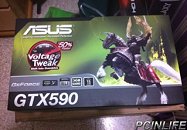
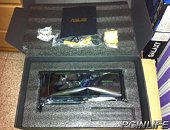
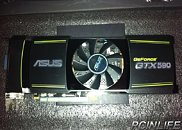
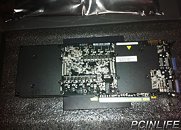
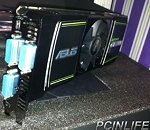
View at TechPowerUp Main Site
The pictures also reveal a little bit about the card. It's a little longer than most NVIDIA GeForce cards released, including the GTX 295. The two GPU systems look well spaced apart from the central fan, which looks to be engineered for higher air-flow. Flipping the card, reveals that NVIDIA did not use a single full-coverage back-plate, rather two smaller ones, that just cover the area behind each GPU, and spread heat from memory chips located at the reverse side of the PCB. Display IO includes three DVI and a mini HDMI. You can use all three DVI connectors at a time, to drive a 3-display NVIDIA 3DVision Surround setup.





View at TechPowerUp Main Site






